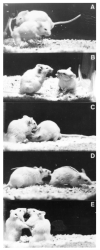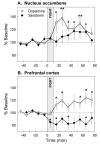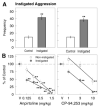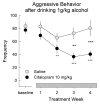Brain serotonin receptors and transporters: initiation vs. termination of escalated aggression
- PMID: 20938650
- PMCID: PMC3684010
- DOI: 10.1007/s00213-010-2000-y
Brain serotonin receptors and transporters: initiation vs. termination of escalated aggression
Abstract
Rationale: Recent findings have shown a complexly regulated 5-HT system as it is linked to different kinds of aggression.
Objective: We focus on (1) phasic and tonic changes of 5-HT and (2) state and trait of aggression, and emphasize the different receptor subtypes, their role in specific brain regions, feed-back regulation and modulation by other amines, acids and peptides.
Results: New pharmacological tools differentiate the first three 5-HT receptor families and their modulation by GABA, glutamate and CRF. Activation of 5-HT(1A), 5-HT(1B) and 5-HT(2A/2C) receptors in mesocorticolimbic areas, reduce species-typical and other aggressive behaviors. In contrast, agonists at 5-HT(1A) and 5-HT(1B) receptors in the medial prefrontal cortex or septal area can increase aggressive behavior under specific conditions. Activation of serotonin transporters reduce mainly pathological aggression. Genetic analyses of aggressive individuals have identified several molecules that affect the 5-HT system directly (e.g., Tph2, 5-HT(1B), 5-HT transporter, Pet1, MAOA) or indirectly (e.g., Neuropeptide Y, αCaMKII, NOS, BDNF). Dysfunction in genes for MAOA escalates pathological aggression in rodents and humans, particularly in interaction with specific experiences.
Conclusions: Feedback to autoreceptors of the 5-HT(1) family and modulation via heteroreceptors are important in the expression of aggressive behavior. Tonic increase of the 5-HT(2) family expression may cause escalated aggression, whereas the phasic increase of 5-HT(2) receptors inhibits aggressive behaviors. Polymorphisms in the genes of 5-HT transporters or rate-limiting synthetic and metabolic enzymes of 5-HT modulate aggression, often requiring interaction with the rearing environment.
Figures






Similar articles
-
Behavioral and pharmacogenetics of aggressive behavior.Curr Top Behav Neurosci. 2012;12:73-138. doi: 10.1007/7854_2011_191. Curr Top Behav Neurosci. 2012. PMID: 22297576 Free PMC article. Review.
-
5-HT1A and 5-HT1B receptor agonists and aggression: a pharmacological challenge of the serotonin deficiency hypothesis.Eur J Pharmacol. 2005 Dec 5;526(1-3):125-39. doi: 10.1016/j.ejphar.2005.09.065. Epub 2005 Nov 28. Eur J Pharmacol. 2005. PMID: 16310183 Review.
-
Social and neural determinants of aggressive behavior: pharmacotherapeutic targets at serotonin, dopamine and gamma-aminobutyric acid systems.Psychopharmacology (Berl). 2002 Oct;163(3-4):434-58. doi: 10.1007/s00213-002-1139-6. Epub 2002 Aug 6. Psychopharmacology (Berl). 2002. PMID: 12373445 Review.
-
Social isolation and expression of serotonergic neurotransmission-related genes in several brain areas of male mice.Genes Brain Behav. 2007 Aug;6(6):529-39. doi: 10.1111/j.1601-183X.2006.00280.x. Epub 2006 Nov 3. Genes Brain Behav. 2007. PMID: 17083332
-
GABA(B) receptor modulation of serotonin neurons in the dorsal raphé nucleus and escalation of aggression in mice.J Neurosci. 2010 Sep 1;30(35):11771-80. doi: 10.1523/JNEUROSCI.1814-10.2010. J Neurosci. 2010. PMID: 20810897 Free PMC article.
Cited by
-
Differential Roles of the Two Raphe Nuclei in Amiable Social Behavior and Aggression - An Optogenetic Study.Front Behav Neurosci. 2018 Aug 2;12:163. doi: 10.3389/fnbeh.2018.00163. eCollection 2018. Front Behav Neurosci. 2018. PMID: 30116182 Free PMC article.
-
Effect of Group Density on the Physiology and Aggressive Behavior of Male Brandt's Voles (Lasiopodomys brandtii).Zool Stud. 2018 Jul 18;57:e35. doi: 10.6620/ZS.2018.57-35. eCollection 2018. Zool Stud. 2018. PMID: 31966275 Free PMC article.
-
Alcohol and violence: neuropeptidergic modulation of monoamine systems.Ann N Y Acad Sci. 2015 Sep;1349(1):96-118. doi: 10.1111/nyas.12862. Epub 2015 Aug 18. Ann N Y Acad Sci. 2015. PMID: 26285061 Free PMC article. Review.
-
Infralimbic and dorsal raphé microinjection of the 5-HT(1B) receptor agonist CP-93,129: attenuation of aggressive behavior in CFW male mice.Psychopharmacology (Berl). 2012 Jul;222(1):117-28. doi: 10.1007/s00213-011-2629-1. Epub 2012 Jan 7. Psychopharmacology (Berl). 2012. PMID: 22222863 Free PMC article.
-
Non-mammalian models in behavioral neuroscience: consequences for biological psychiatry.Front Behav Neurosci. 2015 Sep 8;9:233. doi: 10.3389/fnbeh.2015.00233. eCollection 2015. Front Behav Neurosci. 2015. PMID: 26441567 Free PMC article. Review.
References
-
- Adell A, Celada P, Abellan MT, Artigas F. Origin and functional role of the extracellular serotonin in the midbrain raphe nuclei. Brain Res Rev. 2002;39:154–180. - PubMed
-
- Adell A, Celada P, Artigas F. The role of 5-HT1B receptors in the regulation of serotonin cell firing and release in the rat brain. J Neurochem. 2001;79:172–182. - PubMed
-
- Aghajanian GK, Wang RY. Habenular and other midbrain raphe afferents demonstrated by a modified retrograde tracing technique. Brain Res. 1977;122:229–242. - PubMed
-
- Albers HE, Bamshad M. Role of vasopressin and oxytocin in the control of social behavior in Syrian hamsters (Mesocricetus auratus) Prog Brain Res. 1998;119:395–408. - PubMed
Publication types
MeSH terms
Substances
Grants and funding
LinkOut - more resources
Full Text Sources

